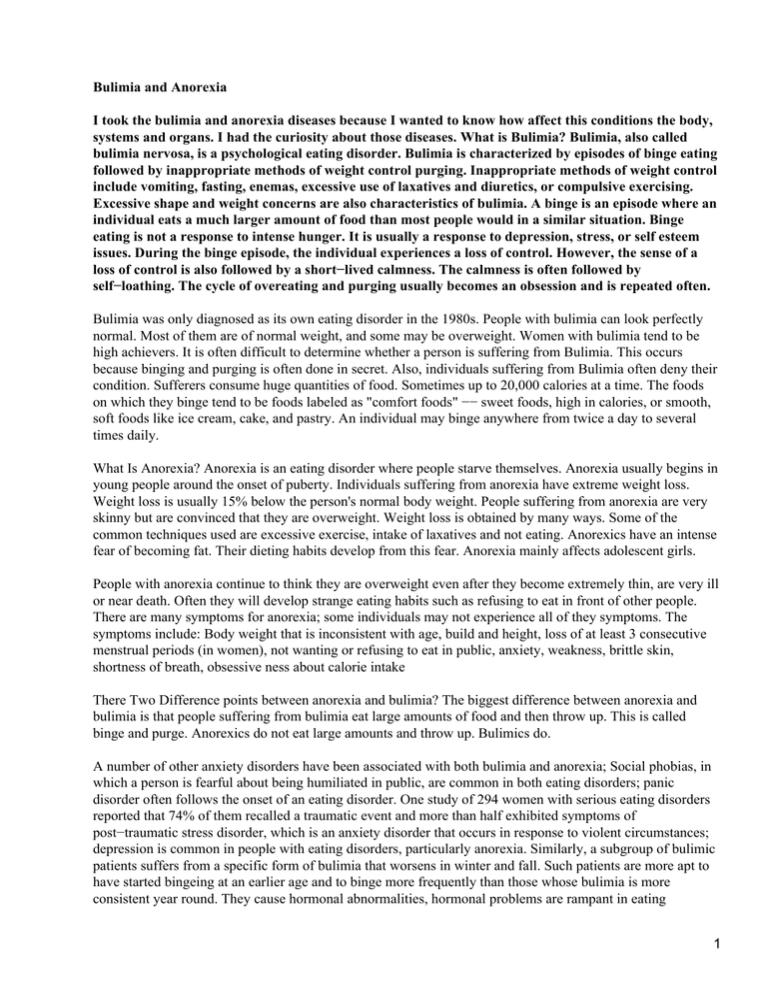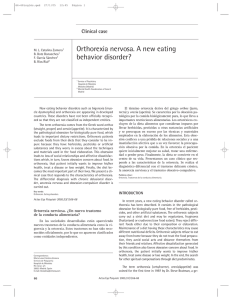Bulimia and Anorexia
Anuncio

Bulimia and Anorexia I took the bulimia and anorexia diseases because I wanted to know how affect this conditions the body, systems and organs. I had the curiosity about those diseases. What is Bulimia? Bulimia, also called bulimia nervosa, is a psychological eating disorder. Bulimia is characterized by episodes of binge eating followed by inappropriate methods of weight control purging. Inappropriate methods of weight control include vomiting, fasting, enemas, excessive use of laxatives and diuretics, or compulsive exercising. Excessive shape and weight concerns are also characteristics of bulimia. A binge is an episode where an individual eats a much larger amount of food than most people would in a similar situation. Binge eating is not a response to intense hunger. It is usually a response to depression, stress, or self esteem issues. During the binge episode, the individual experiences a loss of control. However, the sense of a loss of control is also followed by a short−lived calmness. The calmness is often followed by self−loathing. The cycle of overeating and purging usually becomes an obsession and is repeated often. Bulimia was only diagnosed as its own eating disorder in the 1980s. People with bulimia can look perfectly normal. Most of them are of normal weight, and some may be overweight. Women with bulimia tend to be high achievers. It is often difficult to determine whether a person is suffering from Bulimia. This occurs because binging and purging is often done in secret. Also, individuals suffering from Bulimia often deny their condition. Sufferers consume huge quantities of food. Sometimes up to 20,000 calories at a time. The foods on which they binge tend to be foods labeled as "comfort foods" −− sweet foods, high in calories, or smooth, soft foods like ice cream, cake, and pastry. An individual may binge anywhere from twice a day to several times daily. What Is Anorexia? Anorexia is an eating disorder where people starve themselves. Anorexia usually begins in young people around the onset of puberty. Individuals suffering from anorexia have extreme weight loss. Weight loss is usually 15% below the person's normal body weight. People suffering from anorexia are very skinny but are convinced that they are overweight. Weight loss is obtained by many ways. Some of the common techniques used are excessive exercise, intake of laxatives and not eating. Anorexics have an intense fear of becoming fat. Their dieting habits develop from this fear. Anorexia mainly affects adolescent girls. People with anorexia continue to think they are overweight even after they become extremely thin, are very ill or near death. Often they will develop strange eating habits such as refusing to eat in front of other people. There are many symptoms for anorexia; some individuals may not experience all of they symptoms. The symptoms include: Body weight that is inconsistent with age, build and height, loss of at least 3 consecutive menstrual periods (in women), not wanting or refusing to eat in public, anxiety, weakness, brittle skin, shortness of breath, obsessive ness about calorie intake There Two Difference points between anorexia and bulimia? The biggest difference between anorexia and bulimia is that people suffering from bulimia eat large amounts of food and then throw up. This is called binge and purge. Anorexics do not eat large amounts and throw up. Bulimics do. A number of other anxiety disorders have been associated with both bulimia and anorexia; Social phobias, in which a person is fearful about being humiliated in public, are common in both eating disorders; panic disorder often follows the onset of an eating disorder. One study of 294 women with serious eating disorders reported that 74% of them recalled a traumatic event and more than half exhibited symptoms of post−traumatic stress disorder, which is an anxiety disorder that occurs in response to violent circumstances; depression is common in people with eating disorders, particularly anorexia. Similarly, a subgroup of bulimic patients suffers from a specific form of bulimia that worsens in winter and fall. Such patients are more apt to have started bingeing at an earlier age and to binge more frequently than those whose bulimia is more consistent year round. They cause hormonal abnormalities, hormonal problems are rampant in eating 1 disorders and include chemical abnormalities in the thyroid, the reproductive regions, and areas related to stress, well being, and appetite. Many of these chemical changes are certainly a result of malnutrition or other aspects of eating disorders. The primary setting of many of these abnormalities originate in a small area of the brain called the limbic system. A specific system called hypothalamic−pituitary−adrenal axis may be particularly important in eating disorders. It originates in the following regions in the brain: The hypothalamus is a small structure that plays a role in controlling our behavior, such as eating, sexual behavior and sleeping, and regulates body temperature, emotions; secretion of hormones, and movement, the Pituitary Gland, the pituitary gland develops from an extension of the hypothalamus downwards. It is involved in controlling thyroid functions, the adrenal glands, growth and sexual maturation, Amygdale, This small almond−like structure lies deep in the brain and is associated with regulation and control of major emotional activities, including anxiety, depression, aggression, and affection. Stress Hormones, The HPA systems trigger the production and release of stress hormones called glucocorticoids, including the primary stress hormone cortisol. Chronically elevated levels of stress chemicals have been observed in patients with anorexia and bulimia. Cortisol is very important in marshaling systems throughout the body (including the heart, lungs, circulation, metabolism, immune systems, and skin) to deal quickly with any threat. Studies indicate that stress−hormone related changes occur after anorexia has developed. Abnormalities in the activities of three of them, serotonin, nor epinephrine, and dopamine, are of particular interest. Serotonin is involved with both well−being and appetite (among other traits), and nor epinephrine is a stress hormone. Abnormalities in both have been observed in patients who binge and in those with anorexia or bulimia, low−leptin levels, leptin is a hormone that appears to trigger the hypothalamus to stimulate appetite, and low levels have been observed in people with anorexia and bulimia, low reproductive hormones. The hypothalamic−pituitary system is also responsible for the production of important reproductive hormones that are severely depleted in anorexics. Experts believe that these reproductive abnormalities are a result of anorexia, remained a problem long after weight gain, indicating that hypothalamic−pituitary abnormalities precede the eating disorder itself. Medical Consequences, there are few major health problems for bulimic people, one study comparing adolescents with anorexia and bulimia reported abnormal heart rhythms in patients with anorexia and bulimia. It should be noted, however, that in one study of bulimic and anorexia patients undergoing therapy, after six years the mortality rate was 1%. Those who have both bulimia and anorexia, however, are in great danger and, the disorder, even without anorexia, is not without health problems and serious risks. The following are medical problems associated with bulimia: teeth erosion, cavities, and gum problems, water retention, swelling, and abdominal bloating, occasionally, fluid loss with low potassium levels. This occurs from excessive vomiting or laxative use. In severe cases it can cause extreme weakness, near paralysis, or lethal heart rhythms, acute stomach distress, problems in swallowing, rupture of the esophagus, or food pipe, weakened rectal walls. Heart disease is the most common medical cause of death in people with severe anorexia. The effects of anorexia on the heart are as follows, dangerous heart rhythms, including slow rhythms known as bradycardia, may develop, blood flow is reduced, blood pressure may drop, the heart muscles starve, losing size, cholesterol levels tend to rise, a primary danger to the heart is from abnormalities in the balance of minerals, such as potassium, calcium, magnesium, and phosphate, which are normally dissolved in the body's fluid, the dehydration and starvation that occurs with anorexia. Neurological Problems People with severe anorexia may suffer nerve damage that affects other parts of the body, thinking, brains scans indicate that parts of the brain undergo structural changes and abnormal activity during anorexic states. There is evidence that some damage may be permanent. Therapy for Bulimic and Anorexic, bulimic: Antidepressants, Agents to Prevent Vomiting. Sibutramine (Meridian) is a drug used for weight loss, Inositol. Inositol is a B vitamin that is being investigated for bipolar, anxiety, and depression, therapy for anorexia Antidepressants, Anti−Anxiety Agents, Appetite Stimulants, 2 Atypical Antipsychotic, Agents to Restore Hormonal Function and Bone Density. Normalizing reproductive hormone balances is more important than weight gain in restoring menstrual function. To diagnostic a person which bulimia or anorexia if difficult because sometimes the person with the condition not represent symptoms or the person denied to talk about it. In those cases its important the dialogue between family and the affected. Biography The Merck Manual: Home edition, Ocean Group Editorial, SA, Spain 1 3


